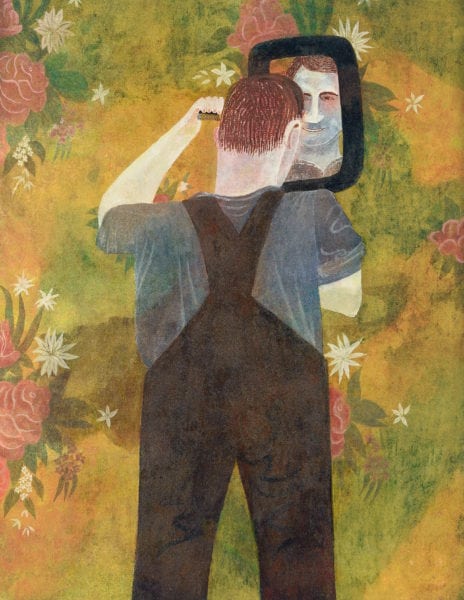Vanity, ca. 1949
Ben ShahnTempera on Masonite
18 × 14 inches
Signed (at lower right): Ben Shahn
Provenance
The Downtown Gallery, New York
Mr. Joseph Gersten, until 1973
Kennedy Galleries, Inc., New York
George Strichman, New York, until 2002
Madron Gallery, Chicago
Completed and exhibited at The Downtown Gallery in 1949, Vanity represents a transitional phase in the course of Shahn’s artistic and personal development. The painting depicts an anonymous figure in the middle of a private moment: standing with his back to the viewer, he combs his hair while smiling approvingly at his image in the mirror. Dressed in a pair of black overalls and a shabby, short-sleeved shirt, the figure is a member of the working class. The positioning of his wide frame, which shields the primary action and the man’s facial features from the viewer’s direct gaze, heightens the scene’s sense of privacy. Meanwhile, the background, a patterned conflation of sunshine and foliage, is a visual tour-de-force of luscious rosebuds and lilies on a vibrant yellow bed.
A departure from his characteristically dark palette, a change described by the artist as the most important element of the work made during those years, the buoyant colors and the man’s mirthful facial expression endow the painting with a distinctive tone of optimism and gaiety. The work’s cheery quality, however, becomes deliberately equivocal when combined with the moralizing overtones of the chosen title. Shahn often created tension within his works by intentionally presenting conflicting elements. Although dignified and proud, the man appears slightly comical, especially in the context of such a frolicsome background. This gentle mocking on the part of the artist serves to sustain the work’s multivalence.
In terms of artistic development, Vanity reflects Shahn’s turn from the direct portrayal of specific individuals and current events toward the use of symbolism and allegory to allude to universal dilemmas of contemporary life. Motivated by a cross-country trip during which he met a variety of people from all walks of life, Shahn recalled:
I had once believed that the incidental, the individual, and the topical were enough; that in such instances of life all of life could be implied. But then I came to feel that that was not enough. I wanted to reach farther, to tap some sort of universal experience, to create symbols that would have such universal quality.[1]
Seeking to achieve this essence without resorting to ambiguous generalities and abstractions, Shahn selected scenes of an intimate, personal nature that reached beyond geographic and temporal boundaries. Accordingly, he advocated the use of symbols “of the most usual and ordinary sort and directly out of the daily, contemporary life of human beings.”[2] In this case, Shahn employed the everyday scene of a man grooming, with which a wide audience could identify, to elaborate upon an issue that he believed was of collective concern, namely the excessive self-preoccupation of American culture that was destroying community bonds and eliminating altruistic acts.
In western iconography, the abstract notion of Vanity is characteristically embodied as an unclothed woman who gazes into a mirror while brushing her hair. Traditionally employed as a warning on the transience of youth and the brevity of life, vanity is also presented as a sin of self-idolatry, where the grace of God is forsaken for a love of oneself. Using elements of this symbolic convention, Shahn subverted preconceptions by making the narcissist a working-class man rather than a beautiful, female nude. This deviation served to alter the message communicated by the painting, functioning in this instance as a reminder of one’s social responsibilities.
In both style and strategy, Vanity is closely related to the work Summertime that resides in the permanent collection of the Addison Gallery of American Art, Andover, MA. Exhibited in the same show at The Downtown Gallery, the paintings both focus on emotionally laden moments in the course of an individual’s everyday life. Displaying a similar background of lush flowers against a field of bright yellow, the composition depicts a grumpy-looking man eating a slice of watermelon. The two paintings are amongst the first of a number of works with one-word titles, such as Anger and Desolation, which elaborate upon the nature of specific emotions or experiences. Seen together, Vanity and Summertime represent an attempt on the part of Shahn to maintain optimism in the face of injustice.
Ultimately, Vanity expresses an appreciation for the beauty of life’s simple pleasures while at the same time functioning as a subtle reminder of their transitory, risky nature. Militant in his humanism, the artist was disgusted by self-centered behavior; accordingly, the painting can be interpreted as a lesson on the social dangers of vanity and insouciance. Greatly concerned with the consequences of a man’s way of life, Shahn used the painting to caution that pride, while not necessarily immoral, could become excessive and lead to a selfish, degenerate lifestyle. Nevertheless, his elaboration on the theme of vanity is not a superficial understanding of life and its trials. Complex in its straightforwardness and sympathetic in its criticism, Vanity is a witty, visually enticing expression of the artist’s inner convictions.
[1] Ben Shahn, “The Biography of a Painting.” Reprinted in John D. Morse, Ed., Ben Shahn (New York: Praeger Publishers, 1972) pp.64-87.
[2] Ben Shahn, “Just What is Realism?” Art Education 3 (December 1950): 4. Reprinted in Frances K. Pohl, Ben Shahn: New Deal Artist in a Cold War Climate, 1947-1954 (Austin: U. of Texas Press, 1989), p. 104.
Exhibited
- Ben Shahn: Exhibition of New Paintings and Drawings, The Downtown Gallery, New York, October 25-November 12, 1949. Cat no.7.
- Ben Shahn – Willem de Kooning – Jackson Pollack, The Arts Club of Chicago, Chicago, Illinois, October 1951. Cat no.12.
- The Comic Spirit, Abraham Shapiro Athletic Center, Brandeis University, Waltham, Massachusetts, June 1952. Cat. no. 102.
- Masters of Egg Tempera, ACA Galleries, New York, New York, October 19-December 2, 2006
Literature
- New York Herald Tribune, October 30, 1949.

